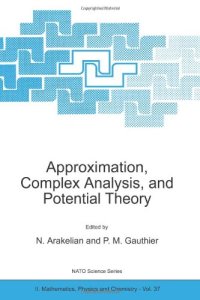
Ebook: Approximation, Complex Analysis, and Potential Theory
- Tags: Computational Mathematics and Numerical Analysis, Fluid- and Aerodynamics, Partial Differential Equations, Applications of Mathematics
- Series: NATO Science Series 37 Series II
- Year: 2001
- Publisher: Springer Netherlands
- Edition: 1
- Language: English
- djvu
Hermann Weyl considered value distribution theory to be the greatest mathematical achievement of the first half of the 20th century. The present lectures show that this beautiful theory is still growing. An important tool is complex approximation and some of the lectures are devoted to this topic. Harmonic approximation started to flourish astonishingly rapidly towards the end of the 20th century, and the latest development, including approximation manifolds, are presented here.
Since de Branges confirmed the Bieberbach conjecture, the primary problem in geometric function theory is to find the precise value of the Bloch constant. After more than half a century without progress, a breakthrough was recently achieved and is presented. Other topics are also presented, including Jensen measures.
A valuable introduction to currently active areas of complex analysis and potential theory. Can be read with profit by both students of analysis and research mathematicians.
Hermann Weyl considered value distribution theory to be the greatest mathematical achievement of the first half of the 20th century. The present lectures show that this beautiful theory is still growing. An important tool is complex approximation and some of the lectures are devoted to this topic. Harmonic approximation started to flourish astonishingly rapidly towards the end of the 20th century, and the latest development, including approximation manifolds, are presented here.
Since de Branges confirmed the Bieberbach conjecture, the primary problem in geometric function theory is to find the precise value of the Bloch constant. After more than half a century without progress, a breakthrough was recently achieved and is presented. Other topics are also presented, including Jensen measures.
A valuable introduction to currently active areas of complex analysis and potential theory. Can be read with profit by both students of analysis and research mathematicians.